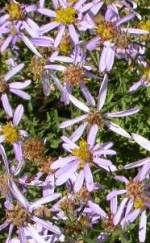 Rhone asters are herbaceous perennials native to southern Europe. They belong to the Asteraceae family that also includes daisies, sunflowrs, and lettuce. The multi-stemmed plants have a bushy habit with small elongated leaves that are hairy, rough, and entire. The flowerheads are produced from late summer to fall and are carried in terminal corymbs of thirty to forty. Each starry flowerhead is 1-1 ¾ inches across and consists of five to ten lavender-blue to pinkish-lilac ray flowers widely spaced around a protruding center of yellow disc flowers. Although the individual flowerheads are not outstanding together to create an impressive look on the plant and attract butterflies. A good choice for a butterfly garden or border. The species is rarely seen because the cultivar ‘Nanus’ is more popular because of its small compact size. The genus name Aster comes from the Latin word aster meaning star referring to the shape of the flowerheads.
Rhone asters are herbaceous perennials native to southern Europe. They belong to the Asteraceae family that also includes daisies, sunflowrs, and lettuce. The multi-stemmed plants have a bushy habit with small elongated leaves that are hairy, rough, and entire. The flowerheads are produced from late summer to fall and are carried in terminal corymbs of thirty to forty. Each starry flowerhead is 1-1 ¾ inches across and consists of five to ten lavender-blue to pinkish-lilac ray flowers widely spaced around a protruding center of yellow disc flowers. Although the individual flowerheads are not outstanding together to create an impressive look on the plant and attract butterflies. A good choice for a butterfly garden or border. The species is rarely seen because the cultivar ‘Nanus’ is more popular because of its small compact size. The genus name Aster comes from the Latin word aster meaning star referring to the shape of the flowerheads.
Type: Herbaceous perennial
Bloom: Flowerheads from late summer to fall carried in terminal corymbs of thirty to forty with each starry flowerhead 1-1 ¾ inches across and consisting of five to ten lavender-blue to pinkish-lilac ray flowers widely spaced around a protruding center of yellow disc flowers.
Size: 2-3’ H 3’ W
Light: Full sun
Soil: Average, moderately moist, well-drained
Hardiness: Zones 4-7
Care: Pinch back before mid summer to encourage bushiness and control growth.
Pests and Diseases: Powdery mildew, aster wilt
Propagation: Division, seed
Companion Plants: Rudbeckia ‘Goldsturm’, Boltonia, Maiden hair grass, Japanese anemone, Sedum ‘Autumn Joy’
Outstanding Selections: ‘Nanus’ (Compact, 18-24” H)